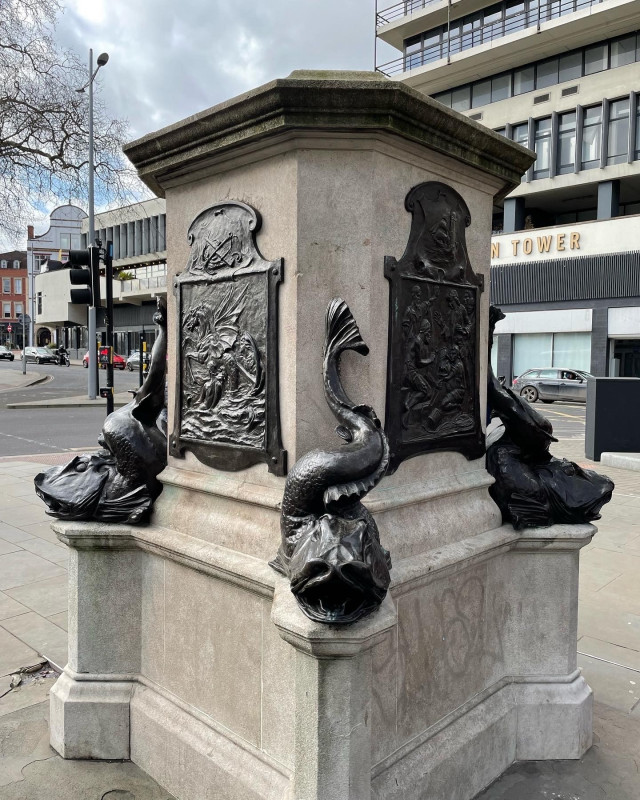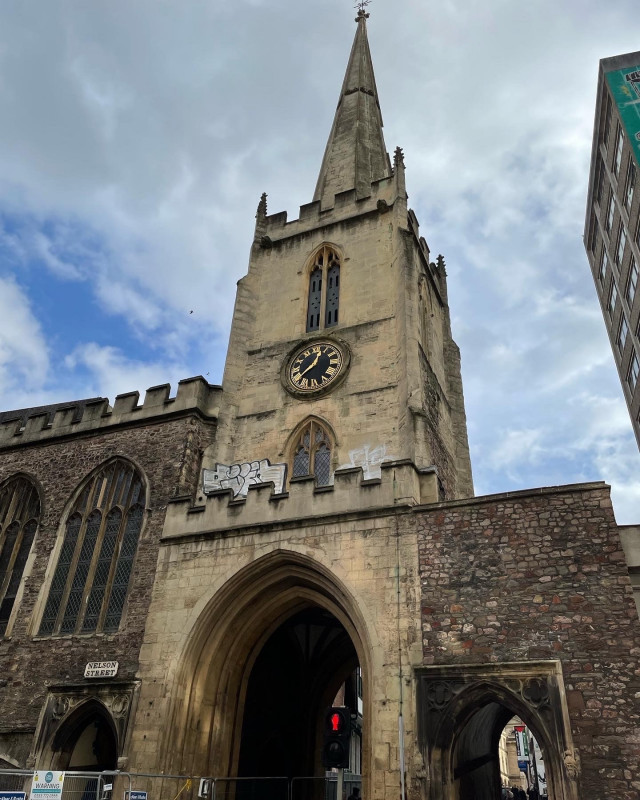At Sarum College we aim to provide a varied, generative and challenging range of experiences which help prepare women and men for public ministry.
In February 2022, the Formation in Ministry team took 40 students on a day trip to Bristol where walked across this wonderful city to look closely at the variety of sounds and sights to explore our organising question: Where and how we speak and act as Christians in the city?
The Bristol visit started with a visit to the Cathedral then to the waterfront and up to the centre, passing the empty plinth where the Colston statue had been. From there we traced the route of the old city wall, including a visit to St John on the Wall, a 14thC church now in the care of the Churches Conservation Trust. Then on to the shopping area of Broadmead and to lunch at John Wesley’s New Room, together with a look at the chapel, the older Methodist building in the world. After lunch we continued through Broadmead and through the Cabot Circus shopping centre, and into the housing and small businesses of Lawrence Hill, to arrive at our final destination at St Nicholas of Tolentino RC Church at Lawford’s Gate.
Three students offer their reflections from the visit. We hope this gives you a glimpse of how theological formation at Sarum is grounded in the context of the variety of communities that the Church of England seeks to serve.
Jacqui Keir-Bucknall, a former headteacher, is a 3rd year ordinand at Sarum College. She lives in North Somerset where she hopes to serve as an SSM curate.
She writes:

As the coach engine silenced, a cacophony of sound and colour lifted from the cathedral green, as though in welcome of our visit – its attention-grabbing clamour of drums, marching resolutely towards a better future, costumes and cries of angry protest. Demonstrators were speaking out for the environment, speaking out against systemic injustice – noble aims for a renewed world… if only the world would listen. An ear-opening reminder of our call to care for creation and to welcome all equally to the kingdom community of God.
Inside the cathedral, pockets of silence slipped between the hushed tones of visitors, providing a stark contrast to the vibrant energy outside. The grandeur of the building, its reverential space, symbols and stained glass windows spoke of a renowned history, yet in the stillness, if you took the time to listen, to really listen to the stories of the past, whispers of suffering and injustice surfaced to capture your heart.
S anitise the narrative displayed in the windows? Install new statues and plaques to speak the whole truth? Or perhaps make restitution by enabling a better future for those impoverished today? The challenging complexity of redeeming the shameful past of slavery is matched by a steely determination to let voices be heard and to create a truly inclusive community where stories intertwine, where all feel equal – a community where all are one in Christ Jesus.
anitise the narrative displayed in the windows? Install new statues and plaques to speak the whole truth? Or perhaps make restitution by enabling a better future for those impoverished today? The challenging complexity of redeeming the shameful past of slavery is matched by a steely determination to let voices be heard and to create a truly inclusive community where stories intertwine, where all feel equal – a community where all are one in Christ Jesus.
Both the noise and silence of this visit echoed our call to participate in the Missio Dei, to be stewards of creation and ministers of reconciliation, both on an individual level and together as the church. Although the latter is often hindered by hierarchical systems and processes, we must rekindle our own efforts with every opportunity and encounter, to demonstrate our commitment to the gospel we profess – shouting loudly against injustice and oppression, listening with compassion to those who are suffering, always attentive to the voice of the Spirit that guides us.
Mark McKnight is an ordinand and student at Sarum College. He lives in Somerset with his wife and two children.
He continues:
 Our walk through Bristol took us to St John on the Wall. Once a busy place of worship, where the bustle of Meieval trade and city life would filter through, now a quiet monument to something that once was. Outside the now de-consecrated church is a water conduit, the large tap now turned off – the life-giving waters no longer flow from it. I am told that the water still flows under the road, but even that has been built over so you cannot get to the waters
Our walk through Bristol took us to St John on the Wall. Once a busy place of worship, where the bustle of Meieval trade and city life would filter through, now a quiet monument to something that once was. Outside the now de-consecrated church is a water conduit, the large tap now turned off – the life-giving waters no longer flow from it. I am told that the water still flows under the road, but even that has been built over so you cannot get to the waters
Is this picture a warning to our Churches to not take our responsibility of being conduits for the Water of Life seriously? Or is this a prophetic rallying call to unstop the blockages, and let the waters flow out of our churches onto our streets?
These unsettled feelings quickly lifted on entering St Nicholas of Tolentino’s Church. Right in front of us were the waters of life. A Baptism pool, laid in the floor of a Church serving a community that is only too familiar with life’s trials, and this is where the waters can be found.
Harry Wainwright is training at Sarum College on the Rural Pathway to be an Assistant Minister. He lives in Bath and owns an independent bookshop located in the suburbs of the city.
He writes:
 Our journey through Bristol was a discomforting experience. It was a sea of relentless contrasts, poverty and plenty, haste and lingering, lamentation and comfort, brokenness and kindness, darkness and light. An episodic pilgrimage through an impermanent, dissonant world left us feeling broken among the broken, disorientated, looking for a spiritual compass. ‘Be strong and courageous’ came to mind as we looked for Christ in a world which seemed forsaken and left behind.
Our journey through Bristol was a discomforting experience. It was a sea of relentless contrasts, poverty and plenty, haste and lingering, lamentation and comfort, brokenness and kindness, darkness and light. An episodic pilgrimage through an impermanent, dissonant world left us feeling broken among the broken, disorientated, looking for a spiritual compass. ‘Be strong and courageous’ came to mind as we looked for Christ in a world which seemed forsaken and left behind.
In a journey of many temples, we felt as if we had been blown off course in Cabot Circus, a temple to consumption. It was an anachronism in a world of poverty and protest. Customers wandered around hypnotised in a gleaming, controlled, reductive world where their economic worth was paramount. It felt strange and uncomfortable. We didn’t want to be there. We were the Israelites, dislocated in a land of abundance.

Crossing the A4044 into Easton was like crossing the Red Sea. We found ourselves in a wilderness. For the first time on our journey, it was quiet. The roads were broken. The signposts were graffitied out. Poverty is modest, but pain and poverty here were visible. There was little here materially, but, as it transpired, plenty that would nourish us spiritually. We encountered Christ embracing nothing less than the total sum of our humanity.
In St Nicholas of Tolentino’s Church, Christ was present in the Eucharist, His feet in the mud and his heart in the Gospel. Every day he died and was resurrected, suffered and triumphed, intimately marking the journeys and resting places of the poor, the hungry, the prisoners, the refugees, the asylum seekers, the homeless, the voiceless. Here was our spiritual compass, Christ embracing the pain and grief of those turning to Him with a permanence which was nothing less then eternal.
The Sarum ministry team is very grateful to our hosts The Very Revd Mandy Ford at Bristol Cathedral, the volunteers at St John’s on the Wall, the team at New Rooms, and Fr Richard McKay and members at St Nicholas of Tolentino.

Leave a Reply